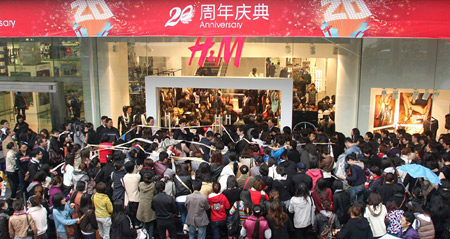*This article is a continuation of a 2 part series. To read Part 1, please click here.
photo via: China Daily
With better wages and the convenience of being able to live together with their families, (something the working class of the Western world never really had to think about), China is heading toward a rise of a populous middle class and a hungry appetite for consumer spending. For example, Zara and H&M, two of the world's largest fast fashion retailers, have seen a huge success this year. H&M is ending this year with a total of 13 new stores, leading to a total of 27, while Zara opened 33 new stores, leading to a total of 60. As the country is becoming more fashion-conscious, these fast fashion retailers are thriving.
In contrast, there is also a new consumer base of young, creative individuals who are looking rather inward to find designs that reflect China's culture and artistry. Young, 20s-30s year olds in China are now looking toward homegrown fashion that reflect a distinctive modern perspective: one that melds Western fashion sense with Chinese culture. We end this 2-part series highlighting a few of their rising stars:
photo via: La Vie Fall/Winter 2011
photo via: La Vie
In addition to utilizing a distinctively Chinese perspective to her designs, Ji is also known as an ethical fashion designer, using eco-friendly fabrics for her lines. "I insisted on eco-friendly materials...It's very comfortable and you can feel the difference," Ji explains, "We want La Vie to be an environmentally friendly brand, but from the business side, we also think this is the future." In La Vie's Fall/Winter 2011 collection titled "Calender Girl," Ji utilized common colors used by the Chinese: Black, Red and White and elements of the traditional "Cheongsam" in modern, Western silhouettes, melding East and West.
While the idea of sustainability is still trying to catch on in China, one store in Shanghai that has taken sustainability to the next level is Nest on Tai Kang Lu in the French Concession district in Shanghai. Dedicated to offering a range of eco-friendly products for the individual and home, Nest comprises of Chinese as well as foreign designs, aimed at supporting "the work of skilled artisans of China and in Asia." Begun by Trine Targett, a Danish native, who sought to contemporize the crafts of traditional Chinese artisans, Nest has become a design incubator and showcase for Chinese-made sustainable design, through its "Design Talk Evenings." The manifesto of Nest is that "the sum is greater than its parts." While sustainability still has a long way to go in China, the fact that there is a store for the purpose of selling exclusively sustainable products is significant, signaling a customer base in Shanghai that is interested in eco-friendly products.


photo via: Art Zine China
photo via: Chinese Coat
photo via: Eblis Hungi
In contrast, clothing brand Eblis Hungi, located on Changle Road in Shanghai's French Concession district, infuses Western men's street wear with a slight Asian sensibility, rather than the more typical East-meets-West perspective. For example, the prints used on Eblis Hungi's hoodies are patterned and sequenced similarly to traditional Chinese prints, while using a cheetah print and their logo: a mummified bean-shape. In addition, the graphics on their t-shirts show a mummified character wearing traditional Chinese garb. Overall, the color used in their graphics and clothing as well as the color combinations definitely allude to a colorful and ornate Chinese aesthetic. For example, the color combinations on their graphic tees are similar to the color combinations used in traditional Chinese buildings such as those in the Forbidden City. In contrast to La Vie and Judy Hua, Eblis Hungi reflects a translating of Western-style for the young, Chinese consumer, rather than a mixing of East and West.
As China is becoming increasingly more important in the fashion community, we can already see a number of young, creative designers who are eager to test the waters and make their mark both locally and globally. While there are many Western brands venturing into the Eastern world, there are just as many Chinese-born designers who are excited to have their designs recognized and worn by their community. Who knows, maybe some day, these designers will have their goods stocked and sold here in the States!



























What a great article! The beauty and cosmetic industries have been developing eco-friendly products and packaging for about a few years now. I knew the fashion industry would soon start to incorporate this trend into product development as well. Although it is a little more challanging to do so in apparel it will start to make a boom soon.
ReplyDeleteTammy